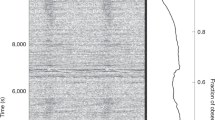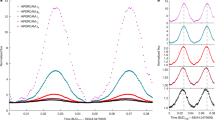Abstract
IN the past four years a total of 13 millisecond pulsars have been found in 12 different globular clusters. These pulsars are believed to be old neutron stars that have been spun up ('recycled') in low-mass X-ray binary systems1 although some may have been formed by the accretion-induced collapse of white dwarfs in binaries2. The globular cluster 47 Tucanae has an especially dense core, and is therefore a likely site for millisecond pulsar formation. Using the Parkes radiotelescope, we have now detected ten addi-tional millisecond pulsars in 47 Tuc, more than half of which are members of binary systems. Almost half of the known millisecond pulsars and more than a quarter of the known binary pulsars now reside in this one cluster.
This is a preview of subscription content, access via your institution
Access options
Subscribe to this journal
Receive 51 print issues and online access
$199.00 per year
only $3.90 per issue
Buy this article
- Purchase on Springer Link
- Instant access to full article PDF
Prices may be subject to local taxes which are calculated during checkout
Similar content being viewed by others
References
Fabian, A. C., Pringle, J. E. & Rees, M. J. Mon. Not. R. astr. Soc. 172, 15P–18P (1975).
Grindlay, J. E. & Bailyn, C. D. Nature 336, 48–50 (1988).
Meylan, G. Astr. Astrophys. 191, 215–226 (1988).
Manchester, R. N. et al. Nature 345, 598–600 (1990).
Fruchter, A. S. et al. Astrophys. J. 351, 642–650 (1990).
Lyne, A. G. et al. Nature 347, 650–652 (1990).
Abies, J. G. et al. IAU Circ. No. 4602 (1988).
Ables, J. G. et al. Nature 342, 158–161 (1989).
Wolszczan, A., Anderson, S., Kulkarni, S. & Prince, T. IAU Circ. No. 4880 (1989).
Wolszczan, A. et al. Nature 337, 531–533 (1989).
Anderson, S. B., Gotham, P. W., Kulkarni, S. R., Prince, T. A. & Wolszczan, A. Nature 346, 42–44 (1990).
Anderson, S. B. Berkeley Pulsar Timing Workshop Rep. (ed. Backer, D. C.) (University of California, Berkeley, 1990).
Biggs, J. B., Lyne, A. G., Manchester, R. N. & Ashworth, M. IAU Circ. No. 4988 (1990).
Verbunt, F. in Timing Neutron Stars (eds Ogelman, H. & van den Heuvel, E. P. J.) 593–608 (Kluwer, Dordrecht, 1989).
Kulkarni, S. R., Narayan, R. & Romani, R. W. Astrophys. J. 356, 174–183 (1990).
Auriere, M., Koch-Miramond, L. & Ortolani, S. Astr. Astrophys. 214, 113–122 (1989).
Rappaport, S., Joss, P. C. & Webbink, R. F. Astrophys. J. 254, 616–640 (1982).
Verbunt, F., Lewin, W. H. G. & van Paradijs, J. Mon. Not. R. astr. Soc. 241, 51–57 (1989).
Author information
Authors and Affiliations
Rights and permissions
About this article
Cite this article
Manchester, R., Lyne, A., Robinson, C. et al. Discovery of ten millisecond pulsars in the globular cluster 47 Tucanae. Nature 352, 219–221 (1991). https://doi.org/10.1038/352219a0
Received:
Accepted:
Issue Date:
DOI: https://doi.org/10.1038/352219a0
This article is cited by
-
A 62-minute orbital period black widow binary in a wide hierarchical triple
Nature (2022)
-
Constraints on the magnetic field in the Galactic halo from globular cluster pulsars
Nature Astronomy (2020)
-
Millisecond Pulsars, their Evolution and Applications
Journal of Astrophysics and Astronomy (2017)
-
The two-hour orbit of a binary millisecond X-ray pulsar
Nature (1998)
-
Earth-based gravitational wave detection from pulsars
General Relativity and Gravitation (1996)
Comments
By submitting a comment you agree to abide by our Terms and Community Guidelines. If you find something abusive or that does not comply with our terms or guidelines please flag it as inappropriate.



